Life at City of Hope: ‘It’s Always a Great Day to Cure Cancer.’
Walking between the wishing trees as one enters City of Hope, it is easy to comprehend what patients and physicians alike mean when they describe the cancer-focused research and treatment center near Los Angeles as unique or ‘just different.’
“There’s a certain intimacy that’s here,” Stephen J. Forman, MD, director of the T Cell Immunotherapy Laboratory and T Cell Therapeutics Research Laboratory at City of Hope and Francis & Kathleen McNamara Distinguished Chair in Hematology and Hematopoietic Cell Transplantation, told Cell Therapy Next in an on-site interview. One colleague’s morning greeting is, “It’s always a great day to cure cancer.”
“It is a phrase everyone understands,” Forman said.
And Forman may understand even more than most. He came to City of Hope in the late 1970s to help develop the burgeoning transplant program and recognized the potential of CAR T-cells as a treatment for cancer 20 years ago.
In those 20 years, Forman has witnessed even more “magic” and recruited his own cohort of magicians from basic scientists to rising stars in the clinical world.
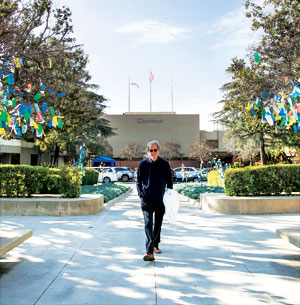
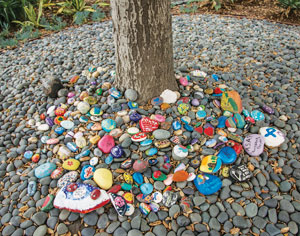
“The first day that we saw a complete remission mediated by CAR T-cells, we just were wordless,” Forman said.

“The overall workings at City of Hope are unlike any other institute in the world,” Saul Priceman, PhD, assistant research professor in the Department of Hematology & Hematopoietic Cell Transplantation and associate director of Translational Sciences & Technologies with the T Cell Therapeutics Research Laboratory, told Cell Therapy Next. “You won’t find clinicians with the immunotherapy expertise as deeply as we have here. That’s because 43 years ago, Forman was at the center of it – that’s when City of Hope performed its first bone marrow transplant. That pioneering cellular therapy and being able to manage more than 15,000 transplant patients so far, is a huge amount of knowledge that has gotten us to this point. Our CAR T-cell therapy program now treats patients with blood cancers, glioblastoma, breast cancer and we are moving into prostate, pancreatic and ovarian cancers and others.”
“Everybody who works here knows why they’re here and if that’s not what they believe, they should work someplace else,” Forman said. “If you’re going to have the luxury of working in a wonderful atmosphere like here, you need to do your part.”
It’s a sentiment shared by his team, including Christine Brown, PhD, associate director of the T Cell Therapeutics Research Laboratory and Heritage Provider Network Professor in Immunotherapy, who is leading City of Hope’s research in CAR T-cell therapy for brain tumors.
“I’m so excited about where we’re headed with City of Hope’s CAR T therapy program, particularly as it pertains to CAR T-cell therapy for solid tumors,” Brown said. “We’re on the cusp of such tremendous potential. There are obstacles out there, but we have so many ideas for overcoming them.”
The City of Hope Difference
Forman explained that a breadth of experience sets City of Hope apart as a cell therapy institution.
“An institution, by the way, that is committed to developing this,” he said. “It’s not a, ‘We’ll do it this month; we’ll do something else next month.’ It is a long-term plan to cure cancer.”
That plan doesn’t just apply to research or cell therapy, he explained. It applies to each patient who enters the City of Hope transplant or CAR T-cell programs.
“When a patient comes here, we extend our hand to them and do not let it go. Wherever a patient’s journey takes them, we go together,” Forman said.

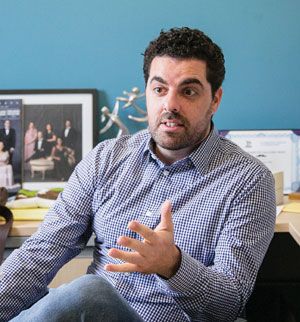


Elizabeth L. Budde, MD, PhD, assistant professor in the Department of Hematology & Hematopoietic Cell Transplantation and co-chair of the Clinical Cellular Immunotherapy Committee, explained further that every physician treating hematologic malignancies also specializes in transplant.
“At City of Hope, we are one of the few centers where we are lymphoma, multiple myeloma or leukemia experts, but we all do transplants,” Budde explained. “We don’t hand our patients over to someone else. As the primary physician, I take the patient through the entire journey. I know their allergies. I know their treatment histories very well. The continuous longitudinal care sets us apart.”
Tanya Siddiqi, MD, associate clinical professor in the Department of Hematology & Hematopoietic Cell Transplantation, told Cell Therapy Next that the patients themselves are part of the City of Hope team and they reciprocate that dedication.
“One of the main things I learn from my clinic is how excited the patients are to ‘find the cure,’” she said. “Every time you talk to patients, they say, ‘We want to do whatever it takes to find the cure so even if we don’t get the benefit, someone else will.’”
Patients and physicians alike come to City of Hope from elsewhere and enter into that agreement.
“People don’t want to work here accidentally. They choose to come here to work and they choose to stay,” she said. “That interplay between scientists, physicians, patients – as a partnership – is a deal we make with patients when they come here. The idea being, if we can figure out tomorrow’s therapy and use them today for you, we’ve done a good day’s work.”
Siddiqi said it is the chance to work with CAR T-cells that motivates her to come to work every day.
“The opportunity at this facility and the people and the environment is just perfect for me to work here and grow as a clinician investigator,” she said.
Budde echoed those sentiments and touted City of Hope’s decades-long progress.
“We have made a lot of progress,” she said. “We are very proud that as of February 1 this year, we have treated 301 CAR T patients since 2000.”
Basic, Clinical Science Interplay
The third piece of the collaborative puzzle for the City of Hope team is the laboratory research that paves the way for clinical breakthroughs.
“We’ve always believed and continue to believe that our laboratory is driven by the needs of the patient and what ultimately leads to a clinical trial,” Forman said.
A great example of this is the collaboration between Priceman, and Tanya Dorff, MD, associate clinical professor in the Department of Medical Oncology & Therapeutics Research, who are about to begin a clinical trial using CAR T-cells in prostate cancer.

“The most unique thing about City of Hope is the intensive collaboration between basic science and clinical research. The whole mission of everyone here is to create new treatments for our patients,” Dorff said. “The fact that Dr. Priceman could create his CAR T, which we can produce on campus and treat patients here, is pretty unique.”
Dorff explained that she, as a clinician, can discuss her experiences with immunotherapy in prostate cancer and suggest new approaches while Priceman is then set up to do preclinical legwork, “So that we make the right next step, we pick the smartest move to give ourselves the best chance of finding something that will benefit our patients.”
Coming from a pharma background, Priceman is still amazed at how quickly and smoothly this collaboration works.


“That’s the most exciting thing is that we uncover and discover in the lab and we can actually take the findings to trial,” Priceman said. “And see it being treated in a patient, which is unbelievable.”
Xiuli Wang, PhD, a research professor in the Department of Hematology & Hematopoietic Cell Transplantation, also touted City of Hope’s translational aspects of CAR T-cell therapy.
“Our research is really driven by our patients. It’s feedback. It’s bench to bedside and back to bench,” Wang said. “City of Hope is very special because research and treatment go hand in hand. Our research is entirely driven by the patient who is only a few steps away in that building. That’s a very special setting that allows us to translate our laboratory discoveries to clinic.”

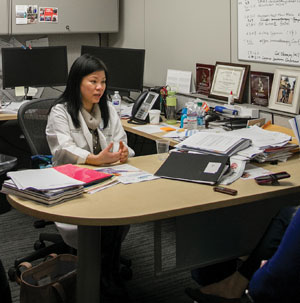
In the setting of phase 1 trials in areas like orphan diseases – blastic plasmacytoid dendritic cell neoplasm (BPDCN) as an example – Budde explained that a setting like City of Hope allows for added flexibility and collaborative discussion.
“The beauty of being able to start your own phase 1 clinical trial is that we can learn from our patients and then we can incorporate what we learned from the patient and modify the protocol immediately because there is a close working relationship between our clinical team and translational research team. We can get specimens from the patient and do investigations in real-time,” she said.
The teamwork then extends to other caregivers, health care providers and others in the cell therapy program, Budde said.
“The Clinical Cellular Immunotherapy Committee is a program we formed in December 2017 with the goal to make sure all physicians, hematologists, oncologists – anyone taking care of CAR T patients – have standardized training and know standardized patient care and ensure patient safety and education protocols,” Budde said.
This committee meets weekly to discuss patients undergoing CAR T-cell therapy in the hospital as well as potential patients’ eligibility.
“If there’s a deviation, we discuss how to address the deviation. ... We discuss if there’s a major event and what we could learn from it,” Budde said. “It’s a very dynamic committee. All CAR T physicians, clinical trial coordinators, CAR T nurses and nurse practitioners and the regulatory team. Everyone is there to discuss.”
And that ability to be dynamic, to adapt to the needs of patients and technology, allows for continued growth at City of Hope.
“In the lab, we really deeply interrogate what’s happening with the patient pretreatment and then serially post treatment, and whether they’re responding or resistant to the therapy. We gain a lot of knowledge, we bring it back to the lab and we can understand how to further improve the response or address the resistance to the therapy,” Priceman said.
Hematologic Progress
Participating in the clinical trials that contributed to the 2017 FDA approvals of CAR T-cell therapies, City of Hope is well versed in hematologic malignancies and the rapid progress.
“There’s a lot of push to see how we can outsmart the lymphoma or leukemia cells. One way is to do dual targeting. Cancer cells can evolve but if we can preempt by targeting two antigens, instead of one, that will be more effective. If treatment doesn’t work against one antigen, then we can still target the other antigen,” Budde said. “This is one of our major focuses to find a safe dual target approach.”

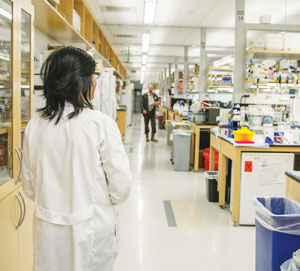

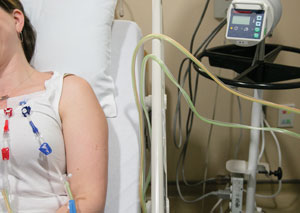
With that in mind, she said her focus is on refractory acute myeloid leukemia and BPDCN, “an orphan disease that even some hematologists don’t know about,” she said.
Wang said campus is also buzzing about a recently opened trial in multiple myeloma.
“We used a new target, which is CS1, so that will be a first-in-human clinical trial. B-cell maturation antigen (BCMA) is the one commonly used for multiple myeloma, but CS1 will be a very good candidate to treat patients who don’t express BCMA. Or maybe it will have better efficacy than BCMA,” she said.
Wang is also working on a CAR T-cell ‘booster’ in which if T-cell counts fall below effective levels, the booster could be administered to raise those levels.
“I developed a platform to expand T cells after infusion. The way I do it is we introduce a CAR into CMV-specific T-cells with a receptor on the cell surface. After the CAR introduction, the T-cells have two specificities. They can recognize the tumor – CD19 – and they can also recognize the CMV antigen,” Wang explained. “If the patient’s T cell levels are low, we can use the CMV vaccine to stimulate these T-cells to expand them in the patient. T-cell persistence is very important for durable remission. If T-cells lower, then they can’t control the tumor. At that time, if you [vaccinate] the patient, the T cells expand again. It’s controllable T cells.”
When asked about the most exciting thing on the horizon for her, Siddiqi quickly said chronic lymphocytic leukemia.
“CLL is a lower grade chronic lymphoma but generally considered incurable. While there’s a need for the more aggressive diseases, in the less aggressive diseases, the problem is you have certain treatments and you run out of options and when the disease comes back, you have nothing to offer patients,” she said. “We are looking at CAR T-cells to cure these patients who historically have no cure.”
In an ongoing trial with Juno, Siddiqi and other researchers are treating patients with CLL who have failed all currently available treatments.
“To date, we’ve had 70% to 80% responses, which is great in people who have already failed a number of treatments. Only time will tell how long these responses will last and whether or not they’re cured,” she said. “To me, that’s the most exciting thing – to actually take an incurable disease and try to cure it.”
While the CLL trial is still ongoing, Siddiqi mentioned that Juno completed another trial for CAR T-cells for diffuse large B cell lymphoma.
“The benefit is there, and the side effects are much less. Maybe it will be better tolerated than commercially available CAR T cells, but with similar efficacy,” she said.
Looking ahead, each clinician and researcher has her own goals.
“In the next decade, I would like to see immunotherapeutics get approved for [acute myeloid leukemia] ... AML is the most common leukemia in adults, but the prognosis is still very poor. Five-year overall survival is only around 30% and as the patients get older, the survival is less. The bar is not very high, but even after so many years, we have not made improvements. It’s not enough,” Budde said.
“I’m hoping that in five to 10 years, we will have tweaked the cellular therapy arena in lymphoma that we would be getting almost complete, durable responses and curing these patients,” Siddiqi said. “There are novel, newer ways that people are trying to get even better responses than we have now because there’s still room to improve.”
“The biggest thing our program wants to try are new CAR T-cell treatments for lymphoma in the brain, using a different route of administration for these T cells,” Siddiqi added, referring to work being done by Wang and Leslie Popplewell, MD, and Jana Portnow, MD, on central nervous system lymphoma. Wang presented impressive data at ASH 2018 on local regional delivery of CAR T-cells to lymphoma in the brains of mice, and a clinical trial led by Popplewell and Portnow will start in the near future.



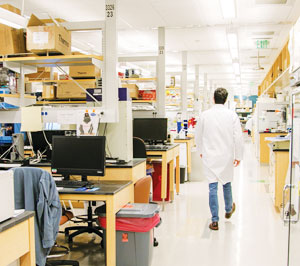
“These T-cells are very potent compared to the intravenously delivered CAR T-cells. We think the CAR T-cells are programmed or armed in this special environment to then circulate out,” Wang said. The clinical trial is designed with the local delivery platform and they hope to begin the trial shortly.
Everything learned in hematologic malignancies will further the field elsewhere, Priceman explained.
“It’s cross-pollination. What we learn in leukemia can directly apply to glioblastoma even though they are two different diseases. We learn from that and it guides us on what we are doing in other diseases. That was really Forman’s brain child. What we are doing in leukemia should inform across the board in every cancer type. And we are not doing our job if we are not getting into all of those cancers,” Priceman said.
Next Steps: Solid Tumors
City of Hope’s work in CAR T therapy for solid tumors started nearly two decades ago. Led by Brown, City of Hope was the first institution to try CAR T-cell therapy on brain tumors, the first to inject those cells directly into the tumor, as opposed to the bloodstream, and the first to introduce CAR T-cells into the cerebrospinal fluid.
“We’ve had patches of responses,” Priceman said. “But the reality is we need to get back to the lab, which we are doing, and make them better soldiers as T-cells and allow them to get in the tumor. Once they’re in the tumor, to stay in the tumor and to live and survive and do what they’re meant to do.”
In 2016, using that local delivery system, Brown and Behnam Badie, MD, chief of the Division of Neurosurgery and Heritage Provider Network Professor in Gene Therapy, treated a glioblastoma patient with his own CAR T cells, and central memory T cells, leading to a cancer regression that was sustained for 7.5 months.
This work in glioblastoma treated with CAR T cells paved the way for other solid tumor research. Priceman’s work has been implemented in two clinical trials: in brain metastases from breast cancer and in prostate cancer, which will open this spring.
“We get to do a regional delivery for brain metastases from either solid or hematological malignancies, which I think gets the T cells to the heart of the problem as quickly as possible instead of roaming around that whole body to find that 1 inch it has to go into,” Priceman said. “This was all based on experiences with treating primary brain tumors, which is a beautiful example of how one program here fertilizes another, no matter how different the disease progression might be.”
For the prostate cancer trial, Priceman is working with Dorff on her passion.
“I’ve been treating prostate cancer for over a decade and I’ve always been a big believer in immunotherapy as the way forward. All of our treatments for advanced prostate cancer don’t result in durable remissions and patients are really looking for that. CAR T and other immunotherapy might be the way to get there,” Dorff said.
The trial is in the process of receiving investigational new drug approval and Dorff anticipates treating the first patient within the month.
“We are already thinking about what else will follow, proving that this is a safe CAR construct,” Dorff said. “Although we are hopeful that it will work as a single modality, we are realistic, so we are prepared to move into additional testing both of the single agent or combinations.”

That realism extends beyond prostate cancer.
“I want physicians to recognize that there may not be the kind of overwhelming success that we’ve seen in hematologic malignancies. It may be that it takes a little while to find out which patients both clinically and also molecularly, are the best patients for this type of approach,” Dorff said. “Remaining open minded and optimistic and leveraging tools like advanced imaging to select patients as well as molecular subtyping and all those biomarkers are going to be important to refining this approach.”
Dorff explained that the University of Pennsylvania is targeting a different antigen with its prostate cancer CAR T, but that the institutions are collaborating and sharing any insights that would lift them both.

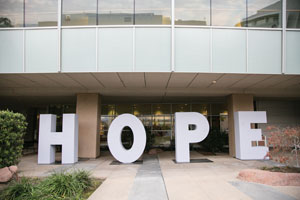
“It could be that both are successful. That would be the optimal outcome because we know that not every patient expresses the same antigens,” Dorff said. “If they learn something as they’re escalating, we hope we can incorporate that. We will be flexible because we want to optimize and make sure that we maximize the likelihood of success and minimize the risk of toxicity.”
She went on to explain it is this return on investment that she feels is best encouraged at City of Hope.
“This is an institution that’s been doing bone marrow transplant and cellular immunotherapy for more than four decades. Thousands of patients have been treated. Everything from the nursing to pharmacy to the clinical trials infrastructure to capturing toxicity and reporting it and keeping everyone safe, we have that whole infrastructure,” Dorff said. “To be honest, I wouldn’t want to put something first-in-human without all that support behind me. I wouldn’t want to risk my patients without feeling really confident that we can do this safely and give them the best return on their investments, which are their bodies, their lives.”
“We recognize this is such a new frontier and when we treat that first patient, it’s a little moment of anxiety, but I have the back-up of the CAR T experience here with collective knowledge and wisdom,” she added.
That infrastructure lends itself to City of Hope’s commitment to push CAR T-cell therapies into solid tumors and other disease states, Dorff said.
“At the laboratory level – which is fed by the clinical experience – we are doing things that we know will fit into a clinical trial. It’s just translational research but it’s so smooth here,” Priceman said. “Here I am just over five years in this program and taking two therapies from inception to trial. It’s a huge feat and it’s because all of the phases of development that go from the lab bench to treating the patient are here and it works very well.”
Mountain-sized Dreams
Forman started dreaming of cell therapies and curing cancer four decades ago and has not stopped.
“We would fantasize about just how far we could take this, just how early can we make this, and I have fantasies about a chemo-free approach to treating cancer,” Forman said.
And the team Forman brought to this intimate hospital and research facility has the freedom to dream as well.
“My pie-in-the-sky is that prostate cancer patients who were previously relegated to ongoing, continual palliative therapy might have an option that will get them to a remission where they don’t have to be forever on androgen suppression,” Dorff said. “I know what an impact that will make because I’ve seen how it takes its toll. Of course, we all want to cure cancer, but additionally being able to offer patients hope for that improvement in quality of life would be a game changer for them.”
Forman hopes those game changers come in many different cancers.
“If we could somehow figure out a way to let immune therapies take the place of these harsher therapies, whether it’s transplant or chemotherapy, that would be the goal,” Forman said. “The challenge is to make this apply to a lot more cancers than it is right now. That’s the challenge, and I’d say I get up every morning trying to figure out how to do that. To the extent that we can make CAR T-cell therapy something that provides more hope for people, that’s why we come here.”
And that is why the patients come here, Siddiqi said.
“We do a lot of clinical trial research here at City of Hope because we want to advance the science,” she said. “The patients are good partners in that. They buy into that and they come here because they want to be part of this leading-edge research that we do.”
Forman reflected on the more than 40 years he has walked the paths at City of Hope with a sort of awe, but looks ahead with continued determination.
“Someone stopped me today and said, ‘You know, you have the unique perspective of having been part of the beginning of two fields,’ and I think that is a blessing and an honor,” Forman said. “I’m never satisfied. ... There’s a kind of agitation. Today’s challenge is tomorrow’s accomplishment.” – by Katrina Altersitz
